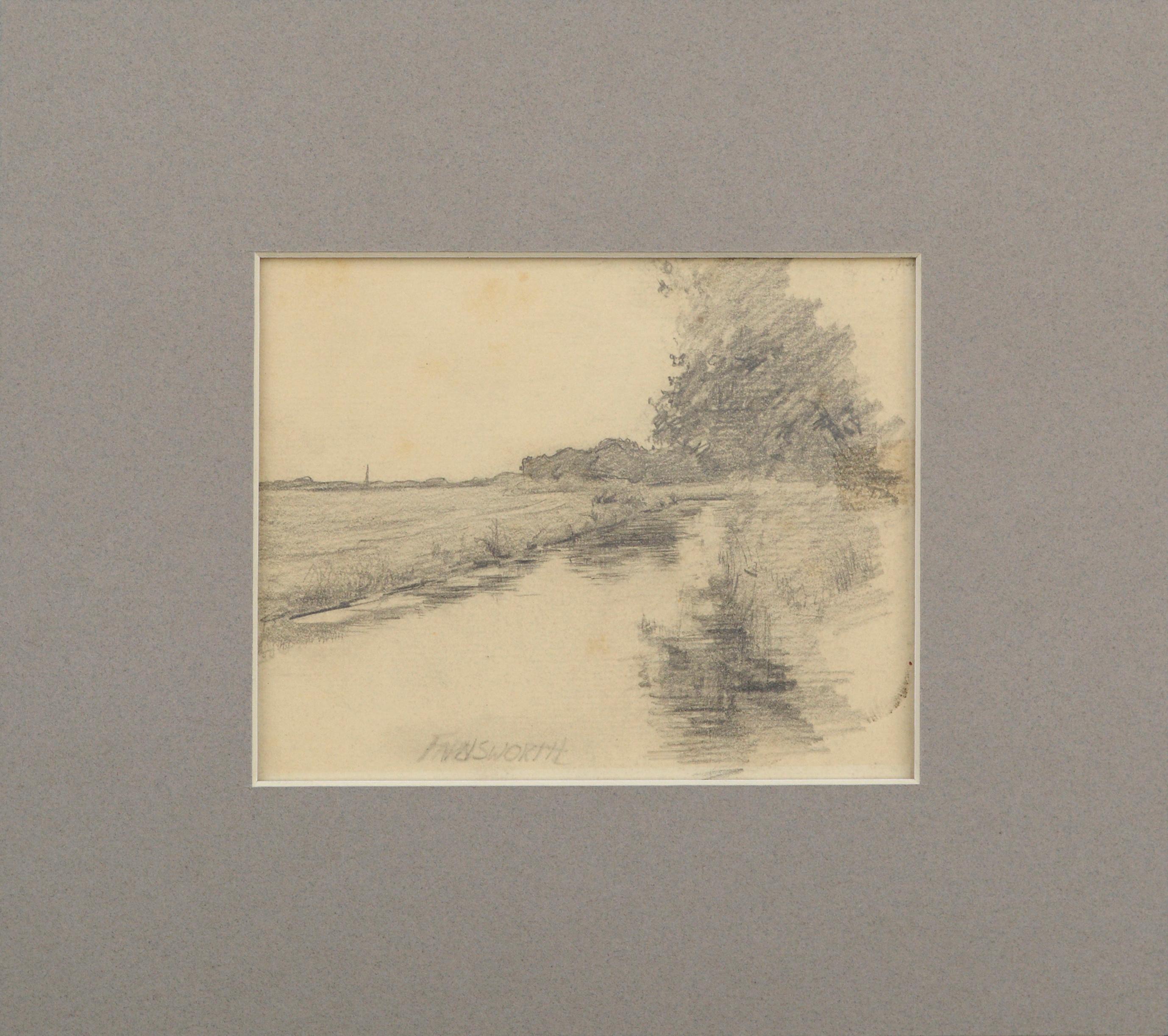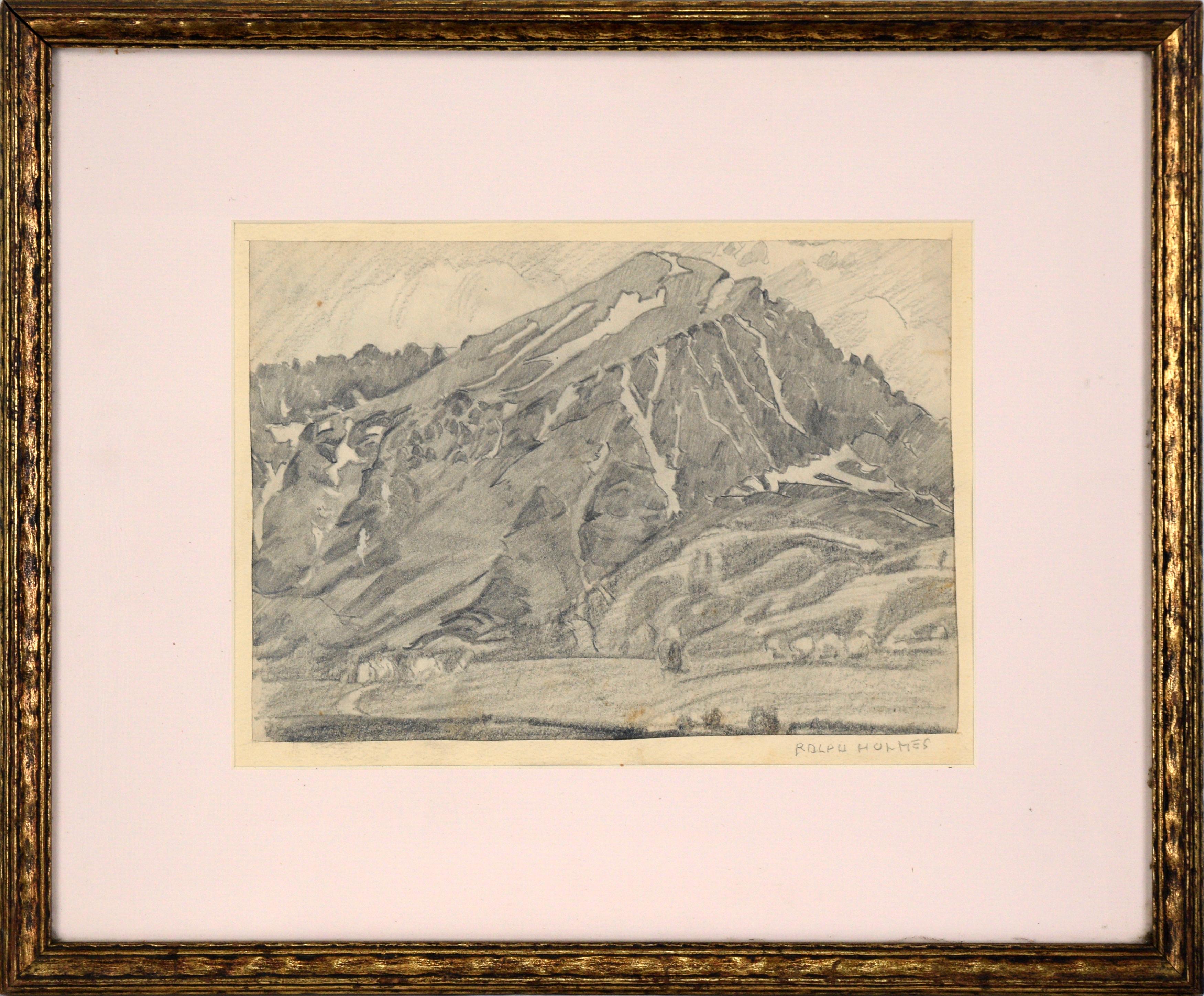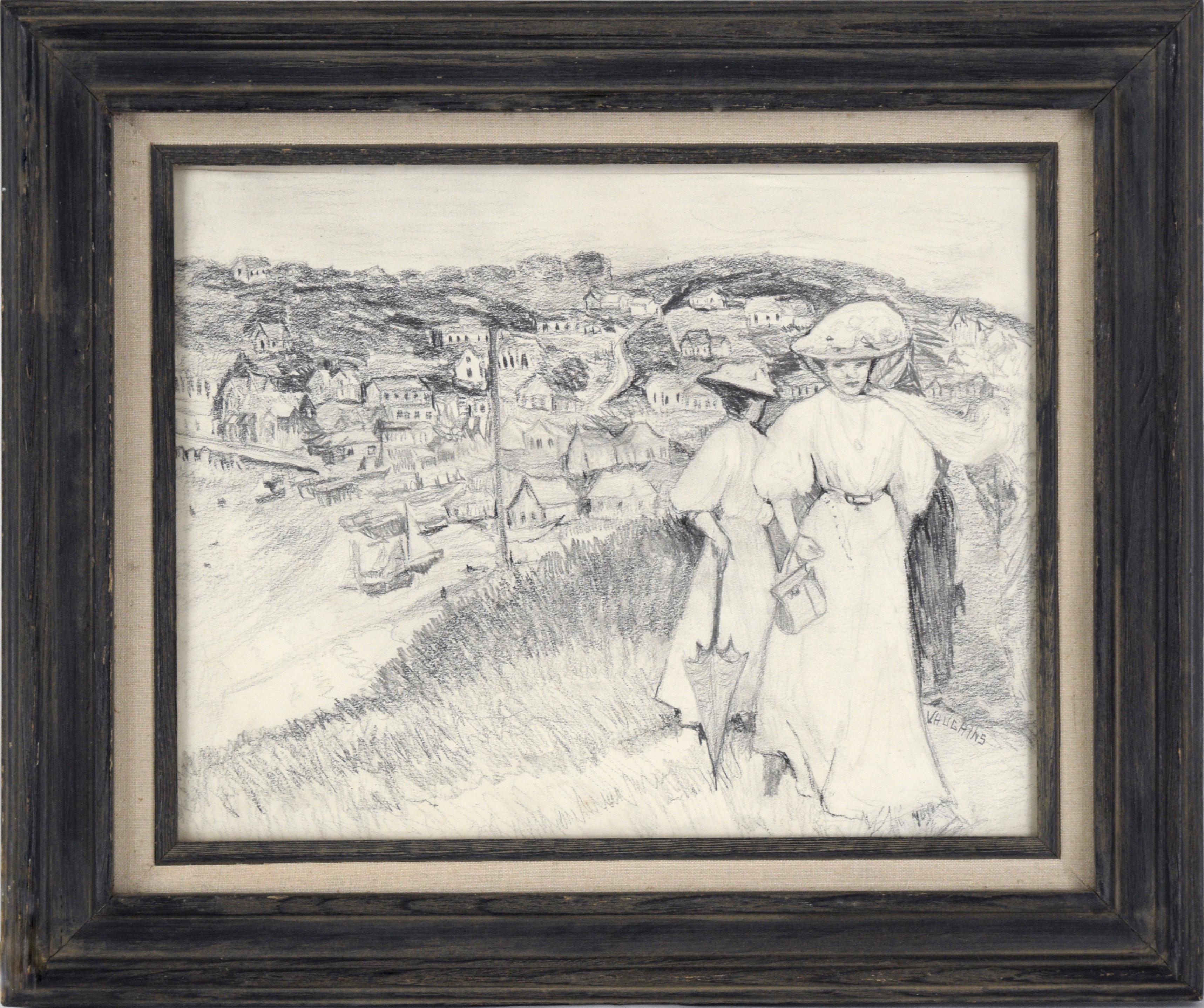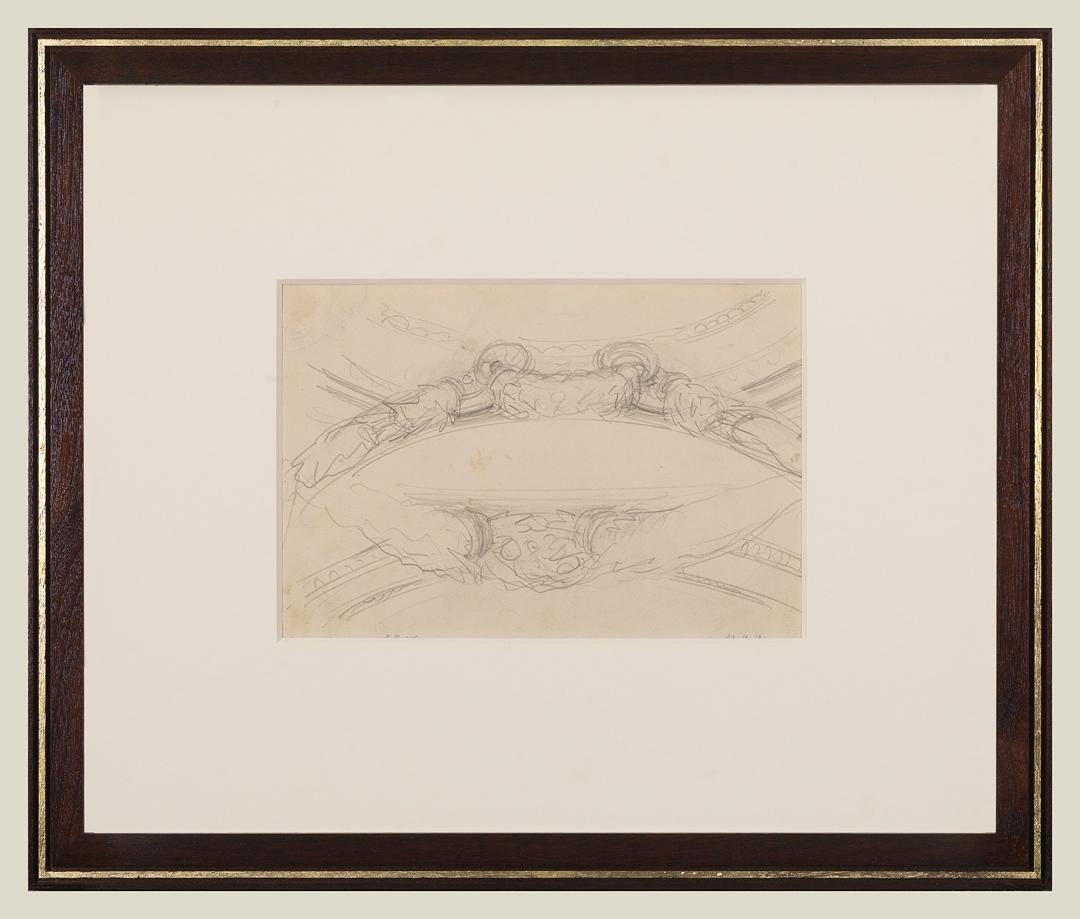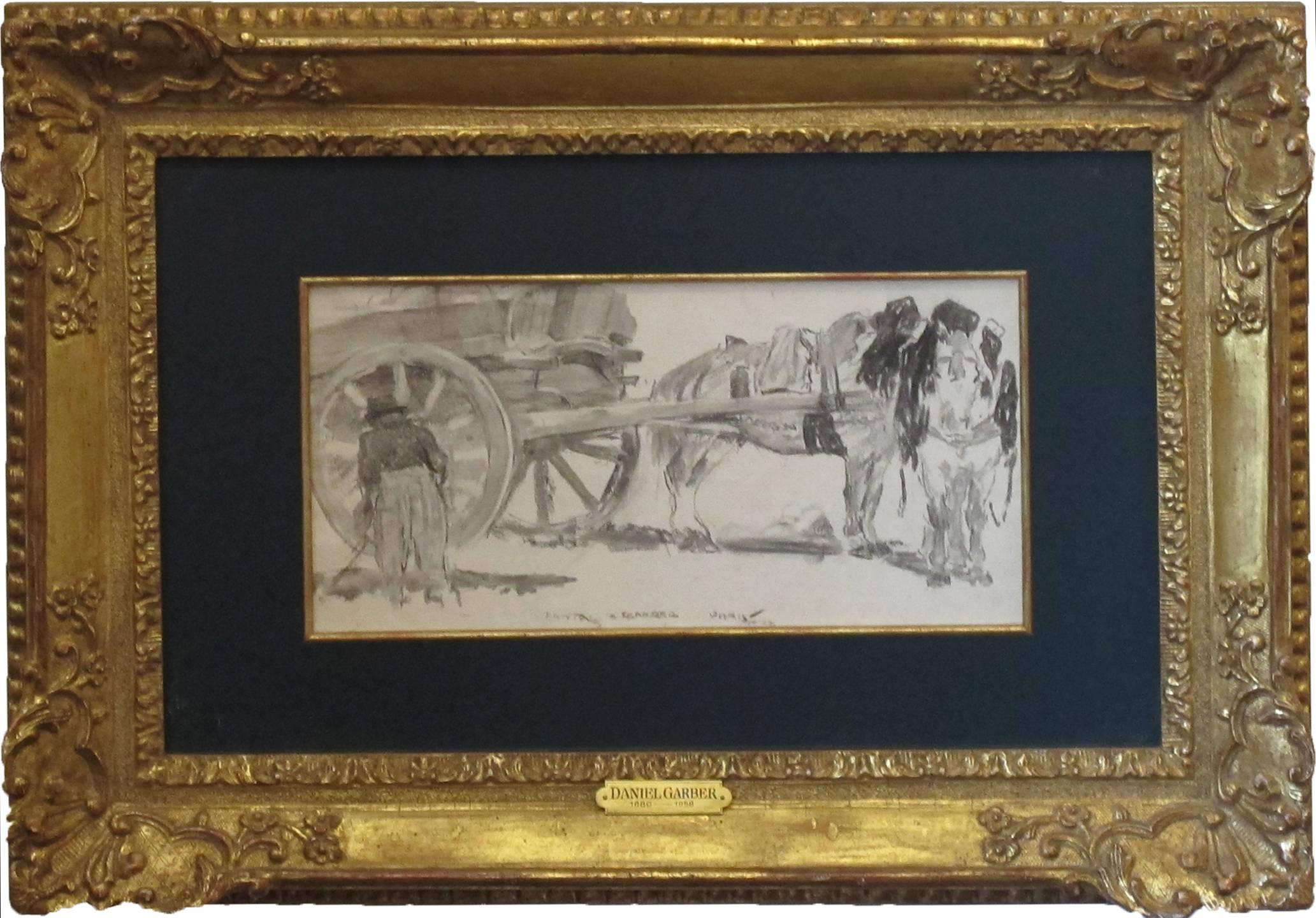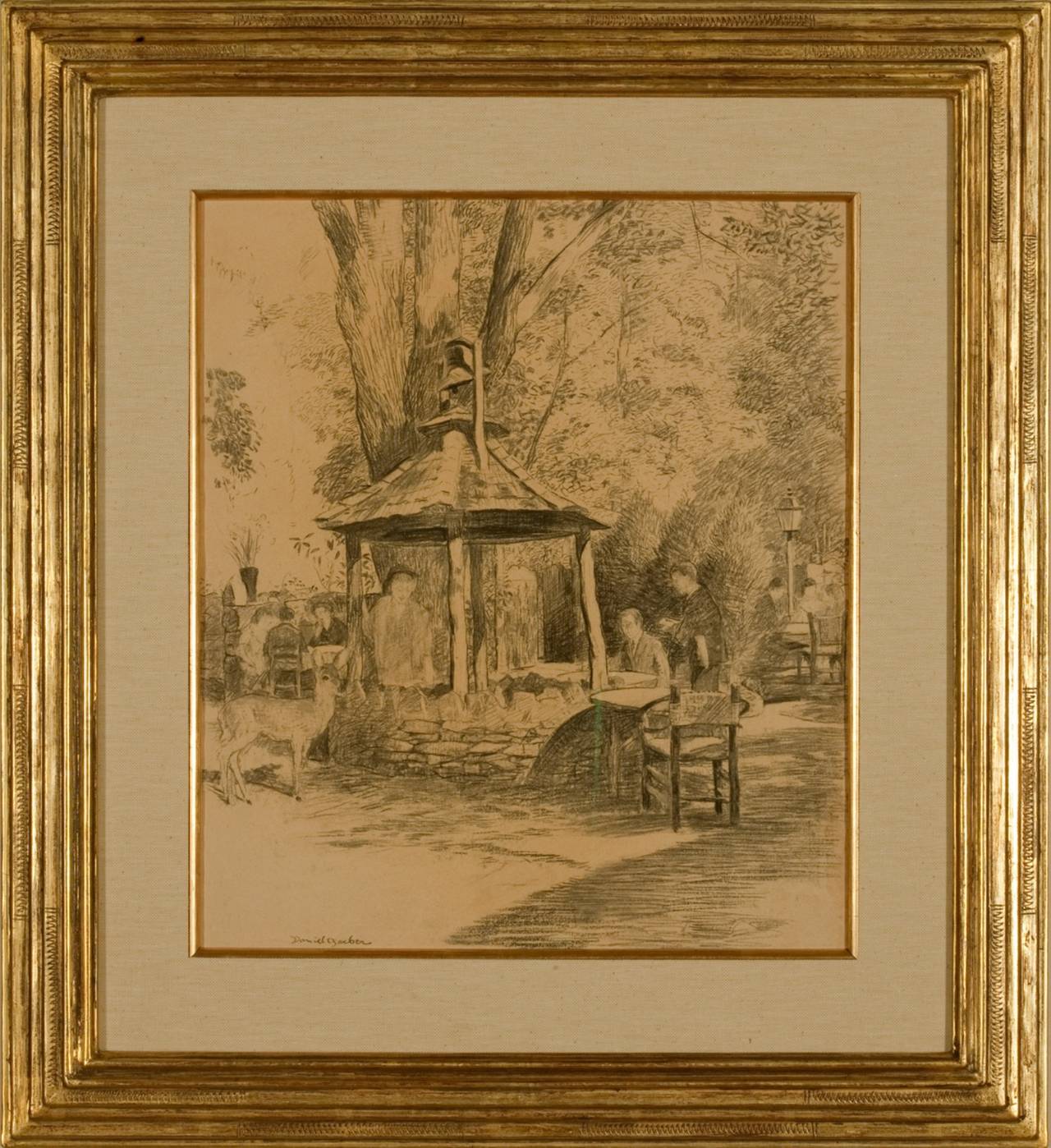Items Similar to "Old Russell House, " Charles Marion Russell, Western American Drawing
Want more images or videos?
Request additional images or videos from the seller
1 of 4
Charles Marion Russell"Old Russell House, " Charles Marion Russell, Western American Drawing
About the Item
Charles Marion Russell (1864 - 1926)
Old Russell House
Pencil on paper
3 1/2 x 6 1/2 inches
Provenance:
Kennedy Galleries, New York
Raydon Galleries, New York
Private Collection, Larchmont, New York
Private Collection, New York, 2019
Charles Marion Russell was born in St. Louis, Missouri, on March 19, 1864. He was the son of a prominent family that had holdings in coal mines and brick manufacturing. Although Russell was raised with the intention of running the family business, he instead developed colorful ambitions toward becoming a cowboy. As a boy, he was a proficient rider and he adopted the ways and manners of his western heroes. His other great ambition was to paint. He was constantly sketching in his schoolbooks and his principal subjects were cowboys and Indians.
In 1880, Russell set out for Montana. He arrived in Helena and took a job as a sheep herder. After a short time, he befriended Jake Hoover, a trapper and hunter, and spent two years with Hoover in the Judith Basin. All the time he continued his painting, spending long hours sketching the wild animals he observed in his daily life. Two years after moving to Montana he hired out as a cowboy, to keep watch on horses, and later as a "night hawk" to watch the cattle at night. Russell was constantly sketching during his off hours and was slowly developing a local reputation as an artist. In 1888, Russell had his first national exposure when one of his sketches appeared in Harper's Weekly, his first paid illustration.
Russell's years as a cowboy were to be very important in his art. His firsthand experiences and his intimate knowledge of the cowboy's tools and ways were to produce the distinctive realism that is characteristic of his style. He portrayed actual events and people in his paintings. Many legends and stories of the West that he often used in his works were originally heard by Russell in evening discussions and camp talk during his years as a cowboy. Russell was also a fervent admirer of the American Indian and often portrayed them as heroic figures struggling to preserve their way of life. In the winter of 1888-89, Russell lived with the primitive Blood Indians in Canada.
By 1892, Russell was a full-time painter. His works were popular in Montana and he was occasionally publishing an illustration for a book or story in a magazine. He was, by nature, a friendly and convivial person. Having no concept of earning his living as a painter, Russell would usually give his sketches and paintings to friends and, at times, would paint a commission for the local saloon in exchange for his bar debts. Although he was becoming famous, he was realizing very little financial gain. On September 9, 1896, he married Nancy Cooper and moved to Great Falls. Nancy immediately became Russell's business manager. She slowly and carefully built up Russell's reputation and stopped his practice of giving away his art. Russell began to sell his paintings at good prices and together, he and Nancy began to enjoy the rewards of fame.
In 1898, Russell cast his first bronzes at the Roman Bronze Works foundry in New York. They were small items but sold well. In 1899, he published Pen Sketches, a collection of prints of cowboy life. These were quickly successful and reprinted in several editions.
By 1903, Russell had a national reputation. He built a log-cabin studio in Great Falls that he stocked with a large collection of artifacts and memorabilia of his cowboy days. In the winter of 1903, he and Nancy went to New York top promote his first eastern art exhibition. On the way, they stopped in St. Louis, where Russell had several paintings in the Louisiana Purchase International Exposition. The New York trip was a failure as they did not sell any paintings. The next year, Nancy persuaded Russell to try again and they returned to New York. They sold several paintings and were able to get Russell's small bronzes established at Tiffany. In addition, Russell became swamped with orders for illustrations.
In 1909, Russell exhibited at the Alaska-Yukon-Pacific Exposition in Seattle, and in 1911, Russell had his first important one-man show in New York, at the Folsom Gallery. That same year, he was commissioned by the State of Montana to do a mural for the Montana House of Representatives, Lewis and Clark Meeting the Flathead Indians. In 1914, he had a successful show at the Dore Galleries in London. By 1915, he was a complete success, getting large prices for his paintings and selling all that he could produce. Success, however, did not change Russell's character or charm. He was still the friendly cowboy and he could not understand why people paid so much money for his work.
In 1920, Russell's health began to weaken. He and Nancy would spend winters in California to avoid the rigors of the Montana climate. After several years of poor health, Charles M. Russell died of a heart attack on October 24, 1926, at the age of 62.
- Creator:Charles Marion Russell (1864-1926, American)
- Dimensions:Height: 3.5 in (8.89 cm)Width: 6.5 in (16.51 cm)
- Medium:
- Movement & Style:
- Period:
- Condition:
- Gallery Location:New York, NY
- Reference Number:1stDibs: LU184129925372
About the Seller
5.0
Platinum Seller
These expertly vetted sellers are 1stDibs' most experienced sellers and are rated highest by our customers.
Established in 2021
1stDibs seller since 2022
60 sales on 1stDibs
Typical response time: 1 hour
- ShippingRetrieving quote...Ships From: New York, NY
- Return PolicyA return for this item may be initiated within 3 days of delivery.
More From This SellerView All
- "Train Station, " Max Kuehne, Industrial City Scene, American ImpressionismBy Max KuehneLocated in New York, NYMax Kuehne (1880 - 1968) Train Station, circa 1910 Watercolor on paper 8 1/4 x 10 1/4 inches Signed lower right Provenance: Private Collection, Illinois Max Kuehne was born in Halle, Germany on November 7, 1880. During his adolescence the family immigrated to America and settled in Flushing, New York. As a young man, Max was active in rowing events, bicycle racing, swimming and sailing. After experimenting with various occupations, Kuehne decided to study art, which led him to William Merritt Chase's famous school in New York; he was trained by Chase himself, then by Kenneth Hayes Miller. Chase was at the peak of his career, and his portraits were especially in demand. Kuehne would have profited from Chase's invaluable lessons in technique, as well as his inspirational personality. Miller, only four years older than Kuehne, was another of the many artists to benefit from Chase's teachings. Even though Miller still would have been under the spell of Chase upon Kuehne's arrival, he was already experimenting with an aestheticism that went beyond Chase's realism and virtuosity of the brush. Later Miller developed a style dependent upon volumetric figures that recall Italian Renaissance prototypes. Kuehne moved from Miller to Robert Henri in 1909. Rockwell Kent, who also studied under Chase, Miller, and Henri, expressed what he felt were their respective contributions: "As Chase had taught us to use our eyes, and Henri to enlist our hearts, Miller called on us to use our heads." (Rockwell Kent, It's Me O Lord: The Autobiography of Rockwell Kent. New York: Dodd, Mead and Co., 1955, p. 83). Henri prompted Kuehne to search out the unvarnished realities of urban living; a notable portion of Henri's stylistic formula was incorporated into his work. Having received such a thorough foundation in art, Kuehne spent a year in Europe's major art museums to study techniques of the old masters. His son Richard named Ernest Lawson as one of Max Kuehne's European traveling companions. In 1911 Kuehne moved to New York where he maintained a studio and painted everyday scenes around him, using the rather Manet-like, dark palette of Henri. A trip to Gloucester during the following summer engendered a brighter palette. In the words of Gallatin (1924, p. 60), during that summer Kuehne "executed some of his most successful pictures, paintings full of sunlight . . . revealing the fact that he was becoming a colorist of considerable distinction." Kuehne was away in England the year of the Armory Show (1913), where he worked on powerful, painterly seascapes on the rocky shores of Cornwall. Possibly inspired by Henri - who had discovered Madrid in 1900 then took classes there in 1906, 1908 and 1912 - Kuehne visited Spain in 1914; in all, he would spend three years there, maintaining a studio in Granada. He developed his own impressionism and a greater simplicity while in Spain, under the influence of the brilliant Mediterranean light. George Bellows convinced Kuehne to spend the summer of 1919 in Rockport, Maine (near Camden). The influence of Bellows was more than casual; he would have intensified Kuehne's commitment to paint life "in the raw" around him. After another brief trip to Spain in 1920, Kuehne went to the other Rockport (Cape Ann, Massachusetts) where he was accepted as a member of the vigorous art colony, spearheaded by Aldro T. Hibbard. Rockport's picturesque ambiance fulfilled the needs of an artist-sailor: as a writer in the Gloucester Daily Times explained, "Max Kuehne came to Rockport to paint, but he stayed to sail." The 1920s was a boom decade for Cape Ann, as it was for the rest of the nation. Kuehne's studio in Rockport was formerly occupied by Jonas Lie. Kuehne spent the summer of 1923 in Paris, where in July, André Breton started a brawl as the curtain went up on a play by his rival Tristan Tzara; the event signified the demise of the Dada movement. Kuehne could not relate to this avant-garde art but was apparently influenced by more traditional painters — the Fauves, Nabis, and painters such as Bonnard. Gallatin perceived a looser handling and more brilliant color in the pictures Kuehne brought back to the States in the fall. In 1926, Kuehne won the First Honorable Mention at the Carnegie Institute, and he re-exhibited there, for example, in 1937 (Before the Wind). Besides painting, Kuehne did sculpture, decorative screens, and furniture work with carved and gilded molding. In addition, he designed and carved his own frames, and John Taylor Adams encouraged Kuehne to execute etchings. Through his talents in all these media he was able to survive the Depression, and during the 1940s and 1950s these activities almost eclipsed his easel painting. In later years, Kuehne's landscapes and still-lifes show the influence of Cézanne and Bonnard, and his style changed radically. Max Kuehne died in 1968. He exhibited his work at the National Academy of Design, the Art Institute of Chicago, the Carnegie Institute in Pittsburgh, the Memorial Art Gallery of the University of Rochester, and in various New York City galleries. Kuehne's works are in the following public collections: the Detroit Institute of Arts (Marine Headland), the Whitney Museum (Diamond Hill...Category
1910s American Impressionist Landscape Drawings and Watercolors
MaterialsPaper, Watercolor
- "Monhegan Island, Maine, " Edward Dufner, American Impressionism Landscape ViewBy Edward DufnerLocated in New York, NYEdward Dufner (1872 - 1957) Monhegan Island, Maine Watercolor on paper Sight 16 x 20 inches Signed lower right With a long-time career as an art teacher and painter of both 'light' and 'dark', Edward Dufner was one of the first students of the Buffalo Fine Arts Academy to earn an Albright Scholarship to study painting in New York. In Buffalo, he had exchanged odd job work for drawing lessons from architect Charles Sumner. He also earned money as an illustrator of a German-language newspaper, and in 1890 took lessons from George Bridgman at the Buffalo Fine Arts Academy. In 1893, using his scholarship, Dufner moved to Manhattan and enrolled at the Art Students League where he studied with Henry Siddons Mowbray, figure painter and muralist. He also did illustration work for Life, Harper's and Scribner's magazines. Five years later, in 1898, Dufner went to Paris where he studied at the Academy Julian with Jean-Paul Laurens and privately with James McNeill Whistler. Verification of this relationship, which has been debated by art scholars, comes from researcher Nancy Turk who located at the Smithsonian Institution two 1927 interviews given by Dufner. Turk wrote that Dufner "talks in detail about Whistler, about how he prepared his canvasas and about numerous pieces he painted. . . A great read, the interview puts to bed" the ongoing confusion about whether or not he studied with Whistler. During his time in France, Dufner summered in the south at Le Pouleu with artists Richard Emil Miller...Category
Early 20th Century American Impressionist Landscape Drawings and Waterco...
MaterialsPaper, Watercolor
- "River Landscape" Julian Alden Weir, American Impressionist, Connecticut SceneBy Julian Alden WeirLocated in New York, NYJulian Alden Weir River Landscape Signed lower left Watercolor on paper 9 x 11 1/2 inches Provenance: Kraushaar Galleries, New York Sotheby's Parke Bernet, New York, 1965, Lot 27 E....Category
Late 19th Century American Impressionist Landscape Drawings and Watercolors
MaterialsWatercolor, Paper
- "Park Street Church, Boston, " John Whorf Impressionist Watercolor WPA CityscapeBy John WhorfLocated in New York, NYJohn Whorf (1903 - 1959) Park Street Church, Boston, circa 1930-45 Watercolor on paper 21 x 15 inches Signed lower right Housed in its original frame Provenance: Milch Gallery, New ...Category
1930s American Impressionist Landscape Drawings and Watercolors
MaterialsWatercolor, Paper
- "Old Adobe Village, New Mexico" Alice Schille, Taos Pueblo, Female ImpressionistBy Alice SchilleLocated in New York, NYAlice Schille Old Adobe Village, New Mexico Signed lower right Watercolor on paper 5 x 6 inches Provenance: Estate of the artist Keny and Johnson Gallery, Columbus, Ohio Santa Fe East Galleries, Santa Fe, New Mexico Private Collection, California A painter in watercolor and oil, Alice Schille was a prolific artist using modernist styles of Post-Impressionism, Pointillism and Fauvism. Her subjects included portraits of women and children, landscapes with and without figures, a series of scenes of New York City. New Mexico, and Gloucester, Massachusetts. Her paintings also reflected her widespread international travels in Europe, North Africa, Russia, the Middle East, Mexico, and Guatemala. Although personally very shy, Schille possessed unusual courage and strength of will, which was reflected in both her independent lifestyle and in her work, as she continually worked to master new modes of painting throughout her career. A German critic once referred to Schille as "this daredevil disciple of art who is interested in anything and afraid of nothing." Alice Schille was born in Columbus, Ohio to a family supported by her father's success in manufacturing. She was raised in Columbus, and by the time she was age six, she determined to be an artist. She graduated at the top of her class from Central High School in 1887, studied from 1891 to 1893 at the Columbus Art School, and returned there as a teacher from 1902 to 1948. Going to New York City as a young woman, she enrolled in the Art Students League from 1897 to 1899 and then the New York School of Art with William Merritt Chase and Kenyon Cox. (Some years later, she attended Chase's Shinnecock Summer School on Long Island). From 1903 to 1904, Alice Schille was in Paris at the Academie Colarosi, and also studied privately with Raphael Collin, Rene Prinet, Gustave Courtois and Chase, who was then in Europe. In 1904, five of her paintings were accepted for exhibition at Societe Nationale des Beaux Arts, and from that time on her work was included regularly in important American annual exhibitions including the Pennsylvania Academy, the Corcoran Gallery, American Watercolor Society, Boston Art Club, and the 1987 inaugural exhibition of the National Museum of Women in the Arts in Washington DC. Between 1905 and 1914, Alice Schille painted in Europe, and during the summers of 1916 to 1918, worked in New York and Gloucester. In 1919, she was in New Mexico. On this trip, her first to the Southwest, she spent a summer in Taos and Santa Fe and painted scenes including the Taos Pueblo, Canyon Road and local Hispanic and Indian figures. Reportedly the Ranchos de Taos Church was one of her favorite subjects. Many of these New Mexico paintings were hung at annual exhibitions of the Philadelphia Water Color Club. Between 1920 and 1940, she traveled frequently in the summers, returning to New Mexico and going to Central America and Africa. In 1922, she began her first series of North-African watercolors...Category
1920s American Impressionist Landscape Drawings and Watercolors
MaterialsPaper, Watercolor
- "House on a Hill, " Clara Bell, Female Artist Landscape, American ImpressionismLocated in New York, NYClara Louise Bell (1886 - 1978) House on a Hill, circa 1935 Gouache on artist board 7 1/4 x 9 7/8 inches Clara Louise Bell (Mrs.Bela Janowsky) was b...Category
1930s American Impressionist Landscape Paintings
MaterialsGouache, Board
You May Also Like
- Reflections in a Pond 19th Century Pencil Drawing by Alfred Villiers FarnsworthLocated in Soquel, CAReflections in the Pond 19th Century Pencil Drawing by Alfred Villiers Farnsworth 19th century drawing in pencil of reflections in a pond ...Category
1880s American Impressionist Landscape Drawings and Watercolors
MaterialsPaper, Pencil
- San Gabriel Mountain Landscape in Black and White - Graphite Pencil on PaperBy Ralph HolmesLocated in Soquel, CASan Gabriel Mountain Landscape in Black and White - Graphite Pencil on Paper Detailed mountain landscape by Ralph Holmes (American, 1876-1963). Signed lower right corner "Ralph Hol...Category
1940s American Impressionist Landscape Drawings and Watercolors
MaterialsPaper, Pencil
- "Yesterday's Ladies" Figurative DrawingBy Virginia J HughinsLocated in Soquel, CACharming "Yesterday's Ladies" drawing by Aptos, California artist Virginia J Hughins,(Virginia Brubaker DeWolf), (American, 1923-2004). Presented in a rustic black wood frame. Signed...Category
1990s American Impressionist Figurative Drawings and Watercolors
MaterialsPaper, Carbon Pencil
- Garland Studies IBy John Singer SargentLocated in New York, NYImage dimensions: 7 ¼ x 10 ½ inches Framed dimensions: 16 ½ x 20 inches To produce his murals, Sargent painted monumental canvases in his studios in London and Boston, adhering them...Category
1920s American Impressionist Landscape Drawings and Watercolors
MaterialsPaper, Pencil
- "Horse Cart"By Daniel GarberLocated in Lambertville, NJJim’s of Lambertville Fine Art Gallery is proud to present this piece by Daniel Garber (1880 - 1958). One of the two most important and, so far, the most valuable of the New Hope Sc...Category
Early 20th Century American Impressionist Landscape Drawings and Waterco...
MaterialsGraphite, Paper
- "Lunch at the Stockton Inn"By Daniel GarberLocated in Lambertville, NJJim’s of Lambertville is proud to offer this artwork. Signed lower left. Pencil drawing. Complemented by a hand carved and gilt frame. Daniel Garber (1880-1958) ...Category
20th Century American Impressionist Landscape Drawings and Watercolors
MaterialsPaper, Pencil
Recently Viewed
View AllMore Ways To Browse
Old House
Houses And People
American Old Painting
Old Antique Houses
Man And A House
Antique Style Houses
Western American Artists
American Western Painting
American Distinctive
American Western Art Paintings
Houser Bronze
Russell And Russell
American Western Landscapes
Canada House
Dior House
Western California
Western Drawings
Old Western Art
